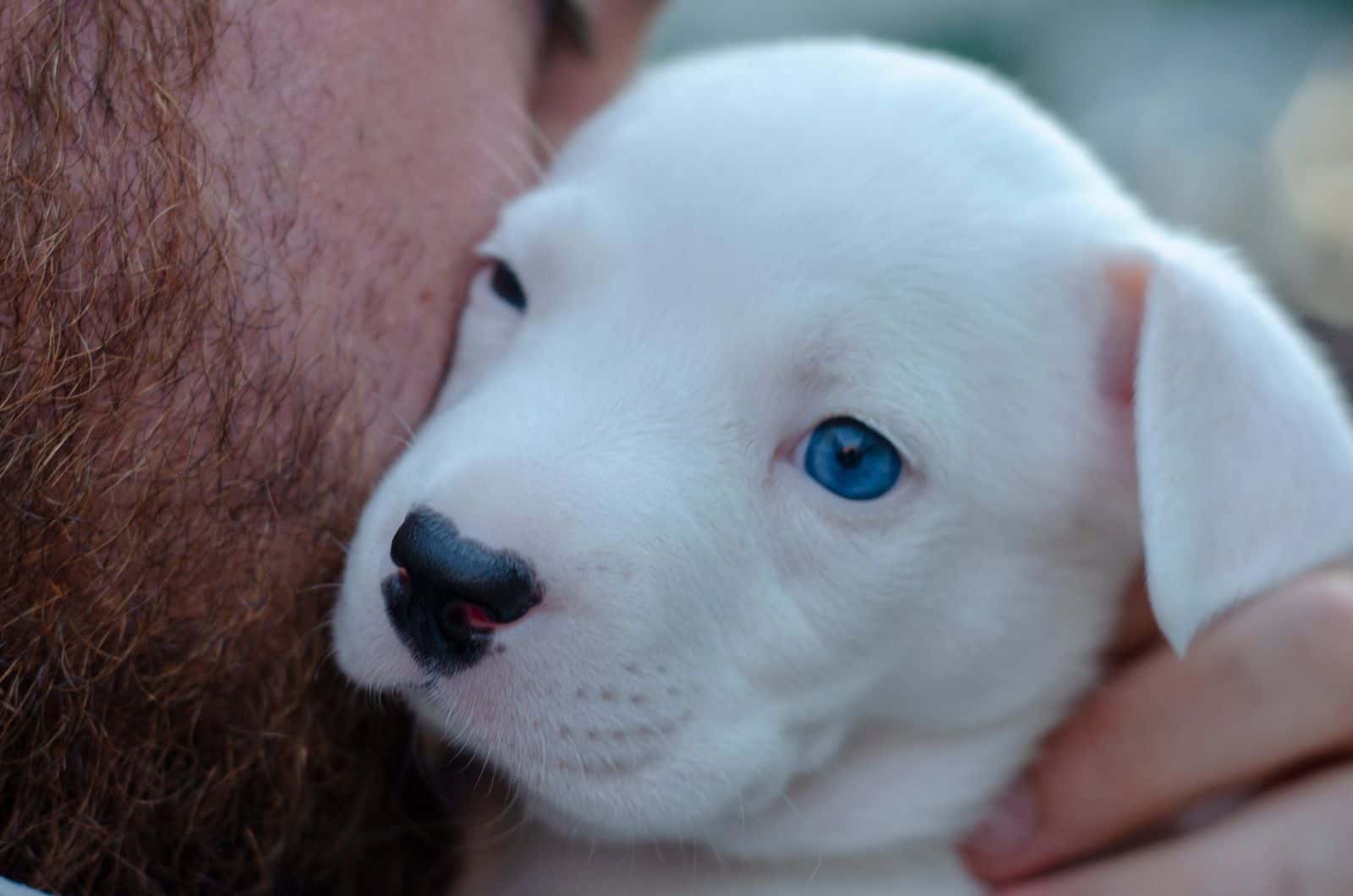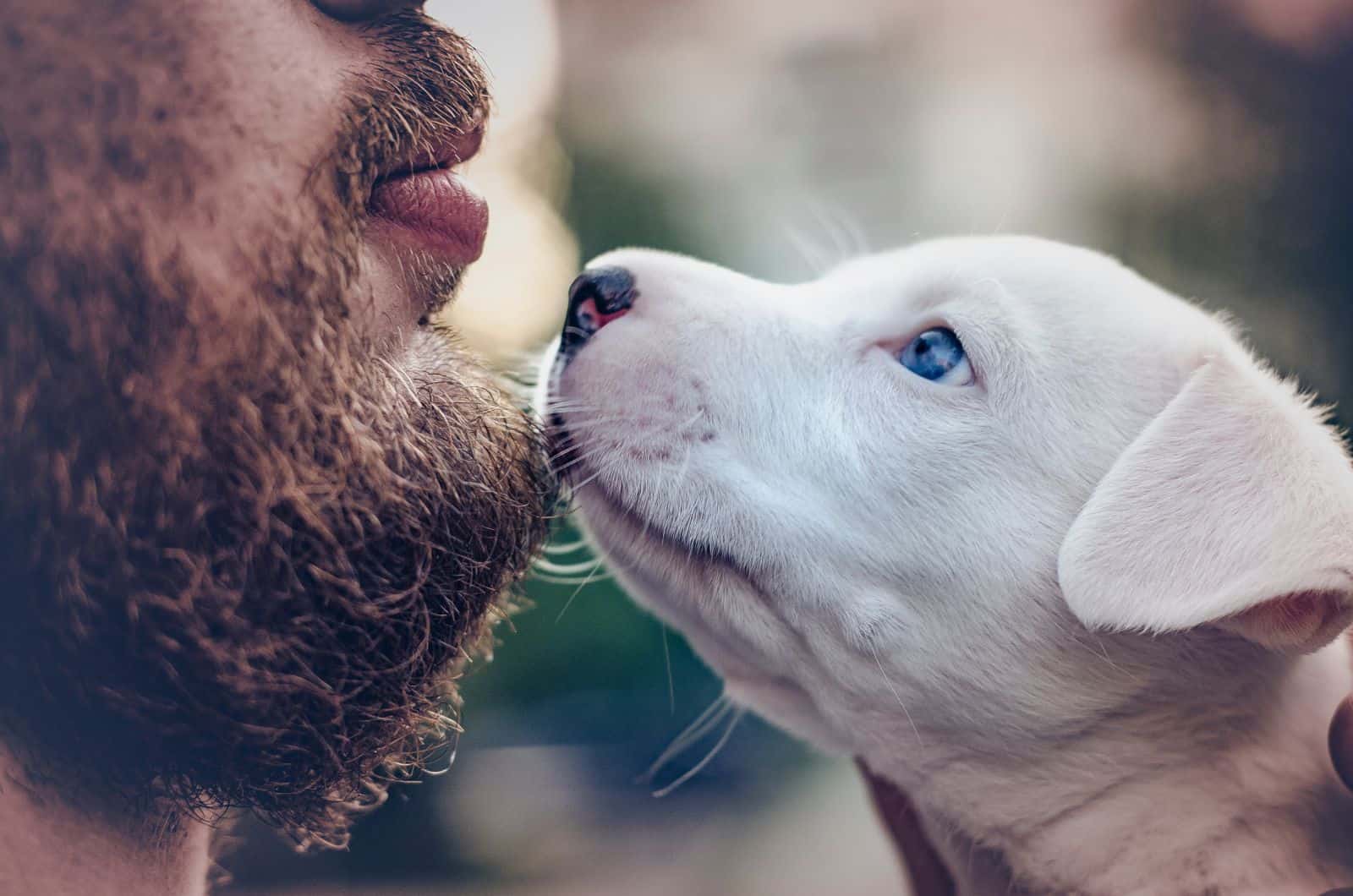Have you ever come across the Blue-Eyed Rottweiler? That’s right… these dogs do exist! However, there is this constant dilemma of how these canines came into existence. Actually, there are several possible explanations for this phenomenon.
For starters, let’s solve the mystery. Blue-eyed Rottweilers are not the AKC standard, but they are still purebred dogs. The American Kennel Club, as well as the ADRK (Allgemeiner Deutscher Rottweiler Klub – the German Rottweiler Club) don’t recognize blue eyes as the standard in a Rottweiler puppy.
Now, let’s get to the chase and see what the possible reasons are for blue eyes in the Rottweiler!
What Is A Blue-Eyed Rottweiler?

To put it simply – a blue-eyed Rottweiler puppy is one of the rarest purebred types of Rottweiler dog. Generally, you can find the purebred Rottweiler with black or brown eyes at reputable Rottweiler breeders.
However, the question of how a Rottie gets rare blue eyes is still a pretty major dilemma among dog experts. Many believe that this unusual phenomenon comes from the fact that these puppies are not entirely purebred, but a mixed breed.
On the other hand, some experts explain this phenomenon as a result of a stray merle gene in the Rottweiler puppy. The merle gene causes changes in pigmentation, which is why they have blue eyes in the first place.
The Origin of The Blue Eyed Rottweiler
Generally, Rottweiler puppies belong to a club of aggressive dog breeds, just like Dobermans, Pitbulls, and Cane Corsos.
Its origin goes back to ancient times, all the way to Rome, when they were initially used as cattle dogs and working dogs. Over time, the breed has become popular all over Europe and the United States, mostly as a guard dog and a working dog.
However, Rottie puppies don’t have the best reputation as these canines have been used as fighting dogs. Still, this beautiful dog has been among families for quite some time now, and it makes a good, reliable family dog, too.
Even though these canines mostly come with black and dark brown eyes, the Blue-Eyed Rottweiler has become quite popular among Rottie lovers.
Where Do Blue-Eyed Rottweilers Come From
Even though the history of the Blue-Eyed Rottweiler is pretty vague, there are four possible explanations for the blue color in this puppy’s eyes.
1. Merle Gene
The first explanation for blue eyes in this canine is the possibility of a stray merle gene in the Rottie’s genetics. The merle gene generally affects the pigmentation of the coat color, and it affects the eye color, too.
Even though the blue color in this puppy’s eyes has a lasting impression on many people, the merle gene often means a higher possibility of developing some diseases.
Merle dogs generally don’t qualify among the healthiest dog breeds in the world, especially those that have been designed as a result of two merle dogs.
Double merle puppies have a high chance of being born deaf or blind. Still, the stray merle gene in a Rottie puppy doesn’t necessarily have to mean a potential disease in a dog.
2. Not A Purebred
As much as we love the blue color in a Rottie’s eyes, this strange phenomenon could mean that this dog is not actually purebred.
Blue-eyed Rottweilers could be a mix of at least two dog breeds, which directly affects the bloodline of this puppy and violates its impeccable DNA. Still, there are some incredible Rottweiler mixes that you will love if you are a Rottie enthusiast.
Having a mixed breed doesn’t necessarily mean having a poor-quality dog as mixed puppies can be great pets, too. However, these canines don’t qualify as AKC-recognized puppies, which disqualifies them from competing in various AKC contests and dog shows.
3. Nuclear Sclerosis
Nuclear, or lenticular sclerosis in dogs, is a well-known condition in middle-aged or senior dogs. This condition represents a bluish haze in a puppy’s lens, but it doesn’t necessarily mean a bad thing.
Even though many people confuse nuclear sclerosis with cataracts – these two conditions are not the same. There is no positive correlation between bad vision and nuclear sclerosis.
Still, a dog needs regular ophthalmologist exams as dogs in their senior years are prone to other eye conditions, such as cataracts.
4. It’s Still A Puppy
The last reason why these canines could have blue eyes is the fact that some of them are still puppies. Generally, all puppies are born with blue eyes, which doesn’t exclude Rottweilers from the list.
As the puppy grows, their bluish color fades and becomes darker. There are several signs that your pet is still in its puppyhood phase, such as blue eyes, puppy teething symptoms, inability to walk properly, or sleeping for the most part of the day.
Generally, the bluish color of dog eyes fades away after the first sixteen weeks, after which these canines get their original eye color.
Physical Appearance Of A Blue-Eyed Rottweiler

These canines are known for their athletic body and strong, muscular physique. The breed has been used as a cattle dog and a working dog, which directly affected this puppy’s great stamina.
These canines belong to the large-breed club as they reach up to 135 pounds in weight. Generally, Rottie owners prefer the Rottweiler raw diet as these canines need a lot of protein and healthy foods in order to remain strong and healthy.
They are moderate shedders, with a short, smooth coat. The breed is known for its floppy ears, strong jaw bite, and massive head. This adorable canine has heavy bones and a wide chest. They are qualified among the strongest dogs on the planet, which makes them ideal for weight-pulling competitions.
Size And Coat Color
According to the breed standard, these canines stand up to 27 inches in height. Their average weight revolves between 95 and 135 pounds.
Even though this is a large dog that burns a lot of calories during the day, the breed requires careful maintenance and a well-prepared feeding chart.
Rottie canines are prone to obesity, which can trigger other diseases in the long run, such as heart disease.
On the other hand, these canines come in three basic coat colors: black and mahogany, black and rust, and black and tan. Since the breed has a short, smooth coat, they don’t require frequent grooming as some other, long-coated breeds do.
Still, if you take your puppy out on a regular basis, make sure you give it at least a monthly bath. Make sure you use the healthiest and best shampoo for your Rottweiler as these canines can have sensitive skin.
Other Eye Colors
Even though some might think that blue-eyed Rottweilers are standard – they are not.
As black and mahogany is probably the most common among Rottweiler coat colors, your new puppy will generally have either black or brown eyes.
In fact, some Rottie clubs disqualify light brown eyes and acknowledge only dark brown eyes in this breed. The darker the eye color in your Rottie puppy – the better. However, Rottie puppies with other eye colors make just as good of pets as these puppies.
If you’re looking for a family pet, its temperament should be the first thing you look into, not its eyes.
The Rottie’s Temperament

Generally, these dogs are independent pets with a strong character. This breed is not recommended for novice owners as these canines require firm leadership and experienced owners. Sometimes, Rottie puppies can be high maintenance as they are not the friendliest type by default.
Early socialization and obedience training should be implemented at the early puppyhood stage. If you have just bought your first Rottie pet, make sure you give it a lot of positive reinforcement.
Interactive dog toys or healthy snacks are a great way to mentally stimulate your puppy. Sometimes, dog training collars are a good training tool, too.
This is a natural guard dog that will do anything to protect its family. Once it gets socialized and well-behaved, the Rottie puppy makes the perfect human companion. Due to their high level of intelligence, these canines are used as law-enforcement dogs, too.
Housing
If you’re planning on keeping your Rottie inside a house, you should start with training from day one. Teaching a puppy basic things, such as using the potty or some basic obedience commands is a must if you want to have a well-mannered dog in the future.
These dogs are extremely intelligent, which means that they get bored easily. They will need a lot of mental stimulation, which is why you need to come up with new ways of entertainment on a daily basis.
Interactive dog toys are a great way to mentally stimulate your puppy and keep it entertained.
Socialized and obedience-trained puppies are perfect family members. Their barking is not that frequent, and they learn all the dos and don’ts very fast. If there is anything Rottweiler puppies can or cannot do – they will know!
Aggressiveness
Even though the breed itself qualifies among the aggressive dogs, these canines are not necessarily aggressive. In fact, there are only a few reasons for their possible aggression.
Mainly, these canines are aggressive towards strangers or enemies. This is a guard dog by default, and it will be reserved towards unknown people.
On the other hand, poorly-trained Rotties can display aggression on occasion. Furthermore, Rotties that feel endangered will naturally act aggressively. Their self-defense mechanism is pretty strong as these canines are used to being guardians.
Lastly, a Rottie puppy will act aggressively as a result of severe anxiety. Even though this is an independent dog breed, you shouldn’t leave it alone for more than a few hours. If you have a busy schedule, you can always entertain your puppy with toys made for Rottweiler dogs.
However, if you are constantly away from home, the recommendation is not to buy this puppy in the first place.
Rotties Around Other Pets And Children
Despite not being on top of the list of the best family dog breeds, well-trained and socialized Rottie puppies have a great way with children. Their tolerance level is high, which makes them perfect even with small children.
They will act protectively around children as they have a great parental instinct. On the other hand, these puppies’ intuition makes them excellent nannies.
However, these canines are not the friendliest dogs to have around other pets or other dogs. Even though they can be taught to behave friendly, these canines have a natural drive for prey, as do most guard dogs.
Health Issues in a Blue-Eyed Rottweiler

These puppies are generally healthy, but they may face some health issues, such as hip dysplasia and cancer.
Hip dysplasia in dogs is pretty serious, and you can notice it in the puppyhood phase.
This hereditary issue represents a loose hip joint, which causes a bunny walk, and other symptoms such as: lack of energy, inability to move properly, and sometimes pain in the legs. This issue is generally treated with surgery.
Furthermore, lymphoma cancer is common for these purebred dogs. If you notice symptoms such as lack of appetite, vomiting, a lump on your dog’s body, diarrhea, or weight loss – visit a veterinarian as soon as possible.
The important thing in owning a Rottweiler is that you always stick to the proper Rottweiler feeding chart. These canines have a tendency to gain weight, which means that they could get obese in no time.
On the other hand, you should give your puppy the proper amount of exercise on a daily basis. This is an athletic dog breed that requires at least sixty to ninety minutes of exercise during the day.
Conclusion

The Blue-Eyed Rottweiler puppy is not the most common Rottie type, but this canine most certainly makes a lasting impression on anyone.
However, the dilemma of whether these dogs are purebred or not is constant and never-ending. Still, the puppy itself represents a good human companion as it is a loyal, excellent guard dog, and it makes a friend for a lifetime.
Read more: 6 Best Treats For Rottweilers: Our Healthy & Yummy Picks















